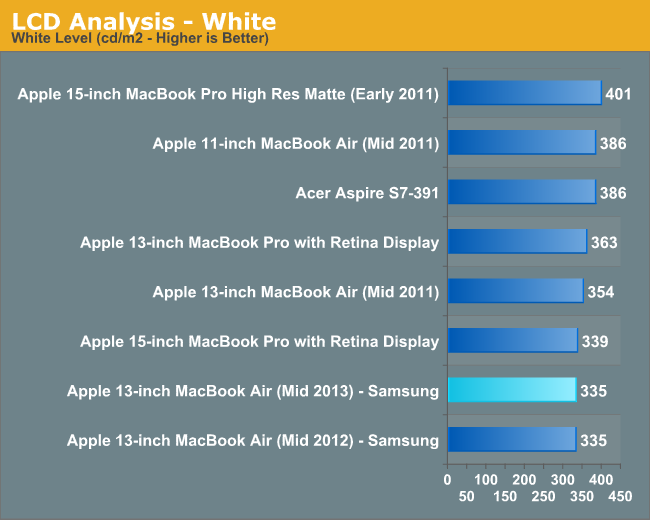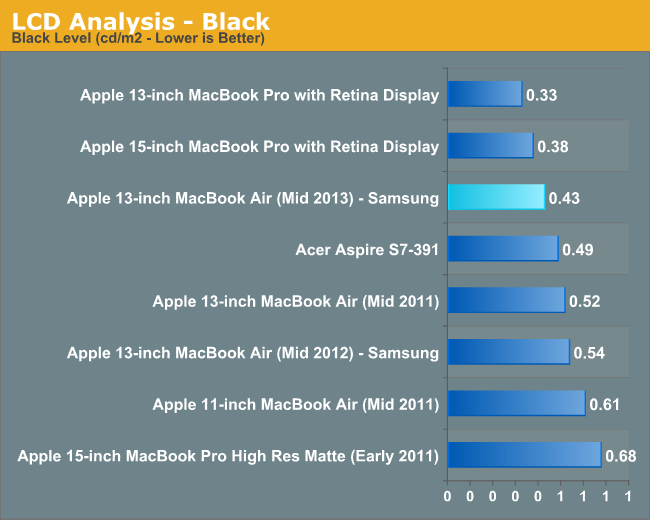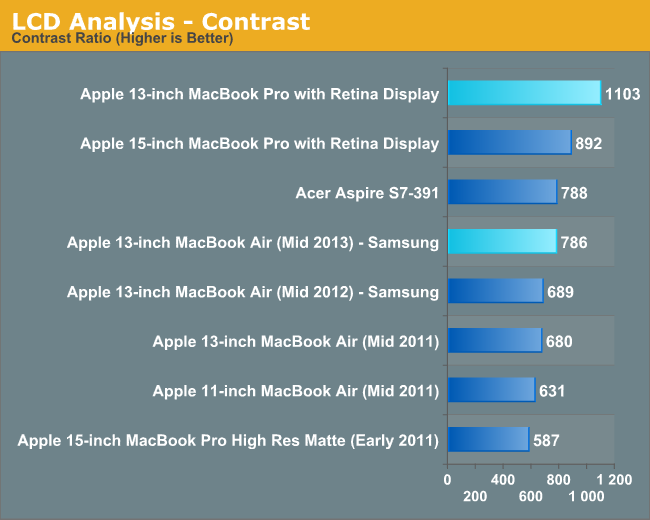The 2013 MacBook Air Review (13-inch)
by Anand Lal Shimpi on June 24, 2013 12:01 AM ESTDisplay
When I reviewed the 13-inch MacBook Pro with Retina Display, I viewed it as the true Retina MacBook Air that everyone was waiting for. With modest increases in thickness and weight, the rMBP13 gave you a much better screen and a larger battery to drive it. Apple’s lineup made sense.
After being in Taiwan earlier this month and checking out all of the 13.3-inch 2560 x 1440 displays being used on notebooks similar in size to the 13-inch MBA, I was beginning to reconsider my position.
To hit an aggressive schedule, you have to mitigate risk. In the case of the 2013 MBAs, Apple kept the chassis spec unchanged in order to do just that. As a result, the displays too, remained unchanged. We’re talking about TN panels (admittedly higher quality than most) and traditional pixel densities. Compared to the Retina Displays deployed across the rest of Apple’s product lines, these panels just aren’t as good. Compared to what you typically find elsewhere, they’re still among the best.

There are two aspects to deploying a Retina Display in a MacBook Air that are worth discussing. The first is power consumption. Greater pixel density requires a more powerful backlight to drive the panel at the same brightness, which in turn reduces battery life. Apple’s solution is to deploy Retina Displays on products it can outfit with a sufficiently large battery. I’d argue that given the battery life of the 2013 MBAs, Apple could move to a Retina Display and still deliver reasonable battery life - but it would be a regression.
The second thing to consider is price. I don’t know just how much more a Retina Display would add to the cost of a MacBook Air, but it’s clear it would be non-negligible.
There’s no real solution to the first problem, but the second one should be less of an issue as panel prices come down. I don’t know where Apple will eventually land on all of this, but today what happens is we get a well defined separation between MacBook Air and MacBook Pro with Retina Display.
Professional users who need greater color accuracy and/or additional desktop resolution really should go for the MacBook Pro with Retina Display. If you don’t need either, the MacBook Air will suffice.
In practice, the MBA’s display isn’t bad by any means. I’ve been staring at it non-stop since WWDC and don’t mind using it at all. The biggest visual issue for me is actually the shifting contrast at off-center vertical angles. It’s not a problem once you properly adjust the display angle but it’s something you don’t have to deal with on the rMBPs. When I'm not in crazy work mode, the lack of resolution isn't a huge deal - but when putting together big articles like this one, I find myself missing the rMBP quite a bit. I guess that's why the rMBP has Pro in the name.



My review sample featured a Samsung panel (LSN133BT01A02), although I’m sure the usual panel lottery is in full effect this generation as it has been in the past. Brightness and contrast are both comparable to what we had last generation (my Samsung panel this year was a bit better than last year's). The brightness/contrast results are very comparable to Acer's 1080p S7, just to show you how far Ultrabooks have come.
I ran the 2013 MBA through Chris Heinonen’s new display workflow using CalMAN to give you an idea of color accuracy vs. the rMBP:



| CalMAN Display Comparison | ||||||||
| Apple iPad (3rd gen) | Apple iPhone 5 | 13-inch rMBP (uncalibrated) | 13-inch 2013 MBA (uncalibrated) | Google Chromebook Pixel | ||||
| Grayscale 200 nits Avg dE2000 | 3.7333 | 3.564 | 1.7825 | 3.348 | 7.132 | |||
| CCT Avg (K) | 6857K | 6925K | 6632K | 6809K | 6442K | |||
| Saturation Sweep Avg dE2000 | 3.193 | 3.591 | 2.1663 | 5.3608 | 7.0927 | |||
| GMB Colorchecker Avg dE2000 | 3.0698 | 4.747 | 2.4521 | 3.9883 | 5.7664 | |||
The 13-inch MacBook Air isn’t bad, but Apple’s Retina Display is just better.













233 Comments
View All Comments
JDG1980 - Monday, June 24, 2013 - link
I think we should have seen noise and thermal measurements, especially since this is Haswell. Will you be able to sit it on your lap without burning yourself? The desktop Haswell chips get nearly hot enough to boil water. I don't believe Intel's official TDP ratings for Haswell; the 4770K allegedly dissipated only 84 watts, but generated more heat than a 130W Sandy Bridge-E.Assuming you plan to use OSX (I can't stand it myself), the low resolution is a real killer. Windows is the only OS that has good font rendering at low DPI (via ClearType). On OSX everything is a blurry mess, and on Linux it's even worse. (Rendering at low DPI is much harder since they have to use a bunch of hacks like hinting and sub-pixel antialiasing to get the font to fit the pixel grid and look reasonably clear.)
It's disappointing to see Apple using Elpida RAM; it's far worse than Hynix or Samsung. And end users shouldn't expect to get the Samsung panel reviewed here; they will almost certainly end up with an inferior LG panel unless they return the system and complain. That's what happened with the rMBP last generation. The sales tactics came close to bait and switch, IMO: send out a good product to reviewers, then after a few months of sales, switch to inferior parts for future production without any indication on the packaging or labeling.
FwFred - Monday, June 24, 2013 - link
Temperature != heat. Also, there is no IHS on a mobile part, so the CPU die may directly be mounted against the cooling solution.mavere - Monday, June 24, 2013 - link
No IHS means no TIM issues means TDP has an extremely, extremely strong correlation to heat and noise, especially as teardowns show similar internal construction. Like the review said, TDP is respectably lowered in Haswell.>>> "It's disappointing to see Apple using Elpida RAM; it's far worse than Hynix or Samsung."
By what metric? Are you claiming that the RAM won't reach their rated speeds? Or are you claiming there's a pending RAM death situation here?
I would love citations in any case.
star-affinity - Monday, June 24, 2013 - link
Don't agree on OS X. It's great overall, once you get used to it. A good start is to not expect everything to behave like in Windows. Also don't agree on the font rendering. If you think it looks better in Windows I'm guessing you're not really into graphic design?tipoo - Thursday, November 6, 2014 - link
I think it does look better, I'm not a graphic designer. However I know OSX may have fonts that are more true to what they were designed as, Cleartype dramatically improves edges on low res displays and makes them bearable. Each pixel effectively becomes three pixels of resolution, so edges are much much smoother. OSX may have "truer" fonts, but chunky looking.A5 - Monday, June 24, 2013 - link
That 130W SB-E die is significantly larger than the 84W Haswell die. Once you add in the fact that more of that TDP is actually being used due to the on-package VRMs, it is pretty obvious why a Haswell would be hotter at the same loads.Paapaa125 - Monday, June 24, 2013 - link
I just used MBA 2011 11" model and the resolution is just fine. At normal viewing distances (30-40cm) the text look clear - no pixels. 135ppi at 40cm means one pixel covers 1,5 arcminutes. That is actually very small unit and quite close to eye resolving power. Definitely you can see the pixels when viewing closer but for normal distances the resolution is 100% sufficient for getting the job done.helloworldv2 - Monday, June 24, 2013 - link
I've been running some terminal stuff for multiple hours with the new i7 model (8GB RAM) utilizing 100% of both cores (4 cores with hyperthreading) and at no point the laptop got uncomfortable to hold on lap (bare skin)..akdj - Wednesday, June 26, 2013 - link
A) Thermal measurements. BS. You don't think the reviewer would've brought to our attention the fact he burned his lap while watching a movie? It's drawing less power at lower clock speeds...there isn't an expectation that the 'heat' on the outside would be anymore significant than the 11/12 core i models. Noise was commented on. In comparison to last year's model, it was quieter while rendering I believe. As well...he mentioned several times throughout the article his anticipation testing the i7 model when he's done flying around the world....yet still submitting a tremendous 'initial' over view or the new Airs. Believe Intel or not....these are 15watt chips. Not 85. Not 130. They're not gonna hurt ya bud.B) OSx. Now your comments are becoming a bit more clear. I use Windows 7/8 and OSx daily. Your comments on text are clearly based on 'what you've heard' and nothing to do with reality. In fact, my friend...'Tis Windows that has awful 'scaling' implementation when it comes to hiDPI displays....including any non native Windows software on the Surface pro. Very troublesome and hopefully will be addressed in 8.1. You're comments on a 'blurry mess' are nothing but BS. @ over 135 dpi on the standard 11" Airs, the resolution in relation to the size of the monitor are just fine! 1080p on that sized display without the same pixel doubling tricks used on the rMBPs would be truly unreadable for most folks over 12 years old! Seriously! I'm an Air and rMBP owner....as well as a PC high resolution display owner. While windows does have some benefits to 'ClearType'....OSx has NO issues with text display. While I'd like to so them step up to IPS, their TN panels, out of the box...have lead the industry for years. Objectively and subjectively. There is NO argument. Windows...on the other hand....they've got a way to go. ClearType isn't the answer. They'll need to implement the same trickery as OSx for text display on HiDPI monitors. No one can see, much less make use of a 2880x1800 display in native Rez. That's the cool thing OSx has managed to pull off....while pixel doubling for text...pics, video, and other creative work can be displayed @ it's native resolution while 'inside' an app using the pixel doubling for its interface. EG; photoshop, FCP....where you CAN have the entire 1080p, every pixel represented inside your canvas while the UI remains usable and crystal clear
Elpida RAM. You are awar that Apple has achieved near 100% efficiency now with their 'soldiered in' RAM. Something NO other user replaceable RAM system can compete with. There are no issues with Elpida...other than the fact you've not heard about them.
LG vs Samsung...very, very arguable. I ended up with an LG in one of our two rMBPs. In four months, image retention set in and Apple immediately replaced it. No questions asked. That said, LG is one of the Biggest and Best panel manufacturers in the world. LG panels in comparison to Samsung have shown better contrast, white and black point....and higher brightness. My Samsung is warmer, but calibrated I've got it pretty close to 6500°. LG is absolutely NOT 'inferior'. They changed out their original panel in the rMBP with an updated version. This is new technology, after all....there are going to be hiccups.
Your 'bait n switch' conspiracy theory is just that. As a small business owner....and as fa from a 'tech reviewer' as one could be....each of my rigs has performed in parity with reviewed models from sites like Anand. No different.
You're full of a WHOLE LOTTA hot air....and obviously have some sort of vendetta against Apple and OSx. Not sure why, maybe your mom said 'Absolutely Not!' When you asked if she would buy you one. Who knows...but quit with the drivel
gxtoast - Monday, June 24, 2013 - link
Fantastic article! However, I just wanted to hit something on the head that seems to be a common misperception:"...In living situations where you can’t just run a bunch of Cat6 everywhere, but still want high speed networking, 802.11ac could be a real alternative."
It seems that most people think that installing Cat6 will give them better 1Gbps Ethernet performance. It won't. Cat6 is irrelevant for 1Gbps. Cat6 is a 10Gbps standard. Cat5e is the 1Gbps standard.
Cheers :)